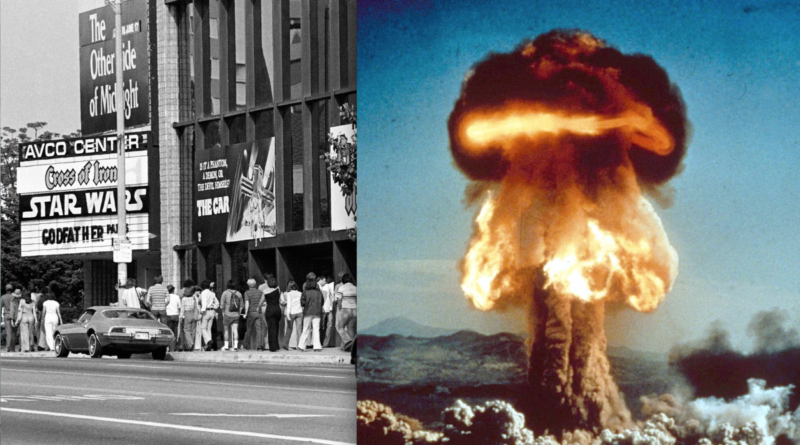'Star Wars' was born with a nuclear explosion, and other weird news from May 25, 1977 – Mashable
Exactly 40 years ago Thursday morning, there was a nuclear explosion in the United States.
No, I don’t mean that as a metaphor for the birth of ‘Star Wars,’ which premiered in 32 theaters that day and went on to transform popular culture. I’m not referring to the planet Alderaan, obliterated by the Death Star, that avatar of our nuclear nightmares.
I mean a literal atomic bomb.
At precisely 8:59:59am local time on May 25 1977, the U.S. detonated a 150-kiloton nuclear device codenamed Crewline in the middle of Nevada. It was buried in a shaft half a klick below ground between Table Mountain and Morey Peak, a valley as desolate as the desert of Tatooine.
This was, of course, just the kind of thing superpowers did in those days, irradiated deserts be damned. Crewline was a little more shallow than Bulkhead, the April 1977 test bomb; it was about 8 times as powerful as Forefoot, the June 1977 nuke on America’s calendar.
And because all this was secret, nobody save the seismologists knew a damn thing about it.
Star Wars might as well have been that secret for all the marketing effort 20th Century Fox had put into it. Studio chiefs thought it was a turkey; their main concern was promoting their expected big hit of the summer, a sleazy soap opera of a movie called The Other Side of Midnight.
If you had your ear to the ground, you could hear the rumble approaching. The Star Wars novelization, released in late 1976, had been a bestseller. The Marvel comic book version of the movie had started flying off newsstands in March. Star Trek was one of the hottest TV shows in syndication, not to mention merchandising; there was clearly an appetite for space stuff.
But not even the most wild-eyed science fiction fan predicted that the movie would make $100 million in just thirteen weeks — enough to set a new world record — and nearly $1 billion before it left theaters. (George Lucas, at his most optimistic, guessed it would make $15 million in total.)
The movie some 32 projectionists were unpacking that morning would set off a seismic event so powerful, our culture would feel its reverberations far, far beyond the era when it seemed normal to set off nuclear weapons every month.
Even without public knowledge of the Crewline bomb, the news of May 25, 1977 was profoundly depressing — which was a big part of the reason audiences were drawn to fun, escapist adventures in the stars.
Former president Richard Nixon had been on TV trying to justify his role in Watergate for 4 nights straight. “When the president does it,” he had just told interviewer David Frost, “that means it is not illegal.” America groaned.
The Vietnam War was over, but its effects were everywhere. On May 25, the Pentagon was moving a load of Agent Orange across country by train so it could be burned in the Pacific (harmlessly, officials claimed).
A cargo plane at Oakland Airport had exploded on the night of May 24, leaving two maintenance workers dead and eight injured.
It wasn’t terrorism. Terrorists were doing far worse things in those days.
For example, a group of former colonial subjects in the Netherlands had just taken 160 children hostage on a train; the crisis would last for another 18 days.
The U.S. economy was in the toilet. The Dow had closed below 1,000, its lowest level in sixteen months. President Carter expressed his concern that the Social Security fund may not last until the 21st century.
In short, you had to dig very deep into the newspaper to find anything positive — such as this curious movie reviewed on page 51 of the San Francisco Chronicle.
Other than those great reviews, however, there wasn’t a whole lot of news about the movie. Star Wars didn’t show up in the papers at all on Thursday May 26, 1977 — unless you count Variety, which noted the eye-popping per-theater grosses from opening day.
It wasn’t until Friday May 27 that reporters and photographers began to cover the long lines of people waiting to see Star Wars, which was beginning to open in dozens more theaters.
TV news didn’t cotton on until the weekend. George Lucas, on vacation with his wife and his friend Steven Spielberg in Hawaii, didn’t know about any of it until he saw famed CBS anchor Walter Cronkite reporting on the lines.
Those lines were a result of supply and demand constraints as much as anything; if 20th Century Fox had managed to get the movie on hundreds of screens to begin with many of the lines wouldn’t even have happened.
And how did Fox react to its good fortune? Mainly, the studio focused on cutting this odd deal with movie theaters that looks baffling at four decades distance: if they wanted Star Wars, they’d have to also screen The Other Side of Midnight.
So as you celebrate the auspicious 40th birthday of the most legendary movie series in history, don’t forget what Day One was actually like. Remember that phenomenons are born in darkness, and its distributors don’t even really know what they’re detonating — just like an underground nuke.
Topics Star Wars
Chris is a veteran journalist and the author of ‘How Star Wars Conquered the Universe.’ Hailing from the U.K., Chris got his start working as a sub editor on national newspapers in London and Glasgow. He moved to the U.S. in 1996, and became senior news writer for Time.com a year later. In 2000, he was named San Francisco bureau chief for Time magazine. He has served as senior editor for Business 2.0, West Coast editor for Fortune Small Business and West Coast web editor for Fast Company.Chris is a graduate of Merton College, Oxford and the Columbia University Graduate School of Journalism. He is also a long-time volunteer at 826 Valencia, the nationwide after-school program co-founded by author Dave Eggers. His book on the history of Star Wars is an international bestseller and has been translated into 11 languages.



